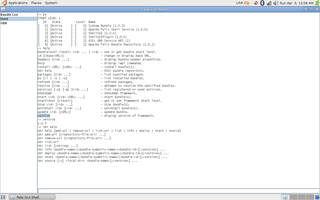The WS-I Basic Profile, a specification from the Web Services Interoperability industry consortium (WS-I), provides interoperability guidance for core Web Services specifications such as SOAP, WSDL, and UDDI. The profile uses Web Services Description Language (WSDL) to enable the description of services as sets of endpoints operating on messages.
The Java Web Services Development Pack (JWSDP) is a free software development kit (SDK) for developing Web Services, Web applications and Java applications with the newest technologies for Java.
The Web Services Invocation Framework (WSIF) supports a simple and flexible Java API for invoking any Web Services Description Language (WSDL)-described service.

Apache Axis is an open-source, XML based Web service framework. It consists of a Java and a C++ implementation of the SOAP server, and various utilities and APIs for generating and deploying Web service applications. Using Apache Axis, developers can create interoperable, distributed computing applications. Axis development takes place under the auspices of the Apache Software Foundation.
Eclipse Jetty is a Java web server and Java Servlet container. While web servers are usually associated with serving documents to people, Jetty is now often used for machine to machine communications, usually within larger software frameworks. Jetty is developed as a free and open source project as part of the Eclipse Foundation. The web server is used in products such as Apache ActiveMQ, Alfresco, Scalatra, Apache Geronimo, Apache Maven, Apache Spark, Google App Engine, Eclipse, FUSE, iDempiere, Twitter's Streaming API and Zimbra. Jetty is also the server in open source projects such as Lift, Eucalyptus, OpenNMS, Red5, Hadoop and I2P. Jetty supports the latest Java Servlet API as well as protocols HTTP/2 and WebSocket.
The Spring Framework is an application framework and inversion of control container for the Java platform. The framework's core features can be used by any Java application, but there are extensions for building web applications on top of the Java EE platform. The framework does not impose any specific programming model.. The framework has become popular in the Java community as an addition to the Enterprise JavaBeans (EJB) model. The Spring Framework is free and open source software.

IONA Technologies was an Irish software company founded in 1991. It began as a campus company linked to Trinity College Dublin had its headquarters in Dublin, and eventually also expanded its offices in Boston and Tokyo. It specialised in distributed service-oriented architecture (SOA) technology, its products connecting systems and applications by creating a network of services without requiring a centralised server or creating an information technology project. IONA was the first Irish company to float on the NASDAQ exchange. It was valued at up to US$1.75 billion at its peak. It was one of the world's 10 largest software-only companies, and around 30 new ventures spun out from it. IONA was sold to Progress Software in 2008.
The Jakarta XML Web Services is a Jakarta EE API for creating web services, particularly SOAP services. JAX-WS is one of the Java XML programming APIs.
Apache ServiceMix is an open-source software project to implement a distributed enterprise service bus (ESB).

Apache Axis2 is a web service engine. It is a redesign and re-write of the widely used Apache Axis SOAP stack. Implementations of Axis2 are available in Java and C.

Apache Felix is an open source implementation of the OSGi Core Release 6 framework specification. The initial codebase was donated from the Oscar project at ObjectWeb. The developers worked on Felix for a full year and have made various improvements while retaining the original footprint and performance. On June 21, 2007, the project graduated from incubation as a top level project and is considered the smallest size software at Apache Software Foundation.
Metro is a high-performance, extensible, easy-to-use web service stack. Although historically an open-source part of the GlassFish application server, it can also be used in a stand-alone configuration. Components of Metro include: JAXB RI, JAX-WS RI, SAAJ RI, StAX and WSIT. Originally available under the CDDL and GPLv2 with classpath exception, it is now available under Eclipse Distribution License
Fuse Services Framework is an open source SOAP and REST web services platform based on Apache CXF for use in enterprise IT organizations. It is productized and supported by the Fuse group at FuseSource Corp. Fuse Services Framework service-enables new and existing systems for use in enterprise SOA infrastructure.
Jakarta RESTful Web Services, is a Jakarta EE API specification that provides support in creating web services according to the Representational State Transfer (REST) architectural pattern. JAX-RS uses annotations, introduced in Java SE 5, to simplify the development and deployment of web service clients and endpoints.

Apache Wink is a retired open source framework that enables development and consumption of REST style web services.

Spring Roo is an open-source software tool that uses convention-over-configuration principles to provide rapid application development of Java-based enterprise software. The resulting applications use common Java technologies such as Spring Framework, Java Persistence API, Thymeleaf, Apache Maven and AspectJ. Spring Roo is a member of the Spring portfolio of projects.
OpenEJB is an open-source, embeddable and lightweight Enterprise JavaBeans Container System and EJB Server, released under the Apache License 2.0. OpenEJB has been integrated with Java EE application servers such as Geronimo and WebObjects.

Apache TomEE is the Java Enterprise Edition of Apache Tomcat that combines several Java enterprise projects including Apache OpenEJB, Apache OpenWebBeans, Apache OpenJPA, Apache MyFaces and others. In October 2011, the project obtained certification by Oracle Corporation as a compatible implementation of the Java EE 6 Web Profile.
Apache Attic is a project of Apache Software Foundation to provide processes to make it clear when an Apache project has reached its end-of-life. The Attic project was created in November 2008. Also the retired projects can be retained.






